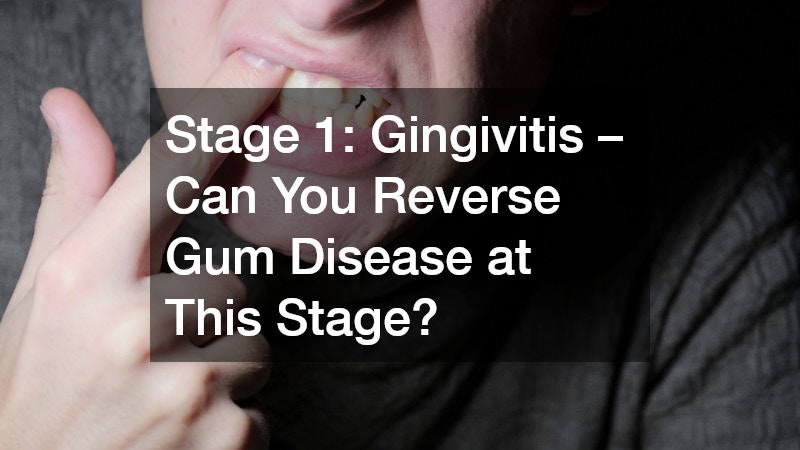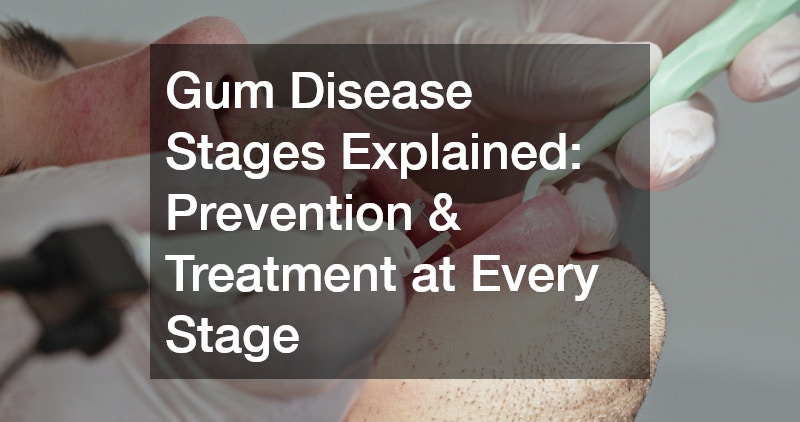Gum disease, also known as periodontal disease, is a common oral health problem that affects millions worldwide. While many people may associate it with bad breath or bleeding gums, understanding the stages of gum disease is crucial for effective prevention and treatment. Early intervention can save your teeth, maintain your smile, and improve your overall health.
This article breaks down the stages of gum disease, how to identify them, and what you can do at each phase to stop progression and restore your oral health. If you’re health-conscious and committed to maintaining a healthy lifestyle, learning about gum disease stages will empower you to take proactive steps in your dental care.
What is Gum Disease? Understanding the Basics
Gum disease is an infection of the tissues that support your teeth. It usually begins with the buildup of plaque—a sticky film of bacteria—on the teeth and along the gum line. If left untreated, this infection can progress and cause inflammation, damage to gum tissue, and even bone loss.
Gum disease typically progresses through several stages, ranging from mild inflammation to severe destruction of the gums and supporting bone. The progression depends on factors like oral hygiene, genetics, smoking, diet, and overall health.
What Are the Stages of Gum Disease?
Gum disease is generally classified into four main stages:
- Gingivitis
- Early Periodontitis
- Moderate Periodontitis
- Advanced Periodontitis
Each stage presents different symptoms and requires different levels of care. Understanding these stages helps you recognize the warning signs and seek appropriate treatment.
Stage 1: Gingivitis – Can You Reverse Gum Disease at This Stage?

Gingivitis is the earliest and mildest stage of gum disease. At this point, the plaque buildup causes the gums to become inflamed, but the bone and connective tissue that hold teeth in place are not yet affected.
Signs and Symptoms of Gingivitis:
- Red, swollen gums
- Bleeding during brushing or flossing
- Mild tenderness
- Bad breath (halitosis)
Because gingivitis affects only the gum tissue and not the underlying bone, it is fully reversible with good oral hygiene and professional cleaning.
Prevention and Treatment at the Gingivitis Stage:
- Brush teeth twice daily with fluoride toothpaste
- Floss daily to remove plaque between teeth
- Use an antibacterial mouthwash to reduce bacteria
- Visit your dentist regularly for professional cleanings
- Avoid smoking and maintain a balanced diet rich in vitamins C and D
Key point: Early diagnosis and treatment of gingivitis prevent progression to more severe gum disease.
Stage 2: Early Periodontitis – What Happens When Gingivitis Is Left Untreated?
If gingivitis is left untreated, it can advance to early periodontitis, where the inflammation spreads to the bone and tissues that support the teeth. At this stage, pockets begin to form between the gums and teeth, allowing bacteria to penetrate deeper.
Symptoms of Early Periodontitis:
- Gums begin to pull away from teeth
- Slight bone loss that is visible on dental X-rays
- Persistent bad breath
- Mild discomfort or sensitivity
Prevention and Treatment of Early Periodontitis:
- Deep cleaning procedures like scaling and root planing to remove plaque and tartar below the gumline
- Improved home care focusing on brushing and flossing techniques
- Use of antimicrobial agents to reduce infection
- More frequent dental visits to monitor gum health
This stage requires professional intervention, but with prompt care, it’s often possible to stop further damage.
Stage 3: Moderate Periodontitis – Can Gum Disease Be Managed?
By the time gum disease reaches moderate periodontitis, the damage becomes more extensive. Gum pockets deepen, more bone loss occurs, and teeth may start to feel loose.
Symptoms of Moderate Periodontitis:
- Noticeable gum recession
- Gum pockets 4-6 mm deep
- Increased bleeding and discomfort
- Loose or shifting teeth
- Possible pus around gums (sign of infection)
Prevention and Treatment for Moderate Periodontitis:
- More intensive cleaning procedures
- Possible use of antibiotics or antimicrobial mouth rinses
- Surgical options like flap surgery to clean deeper pockets
- Regular follow-up visits every 3-4 months
- Lifestyle changes like quitting smoking and managing systemic health issues such as diabetes
Management at this stage aims to halt disease progression and preserve remaining teeth.
Stage 4: Advanced Periodontitis – When Is Tooth Loss Inevitable?
Advanced periodontitis is the most severe form of gum disease, characterized by significant bone loss and tissue destruction. At this stage, teeth may become very loose and may require extraction.
Symptoms of Advanced Periodontitis:
- Deep gum pockets (6 mm or deeper)
- Severe gum recession exposing roots
- Chronic bad breath and taste disturbances
- Tooth mobility or loss
- Abscesses or infections
Treatment for Advanced Periodontitis:
- Complex surgical treatments, including bone grafts and tissue regeneration
- Tooth extraction and replacement options, such as implants or dentures
- Intensive maintenance therapy to prevent recurrence
- Comprehensive periodontal therapy coordinated with dental specialists
While some damage can be repaired, prevention is far better than treatment at this stage.
Why Is It Important to Understand Gum Disease Stages?
Understanding the different stages of gum disease helps you:
- Recognize early warning signs before irreversible damage occurs
- Take timely action to improve your oral health
- Avoid costly and painful procedures down the road
- Maintain a healthier mouth and improve overall well-being
Since gum disease has been linked to systemic health issues such as heart disease, diabetes, and respiratory problems, managing gum health is vital for your entire body.
How Can You Prevent Gum Disease from Developing?

Prevention is the best strategy for avoiding gum disease. Here are practical tips to keep your gums healthy:
- Practice good oral hygiene: Brush twice daily with a soft-bristle toothbrush and fluoride toothpaste; floss at least once a day.
- Regular dental visits: Professional cleanings every six months help remove plaque and tartar buildup.
- Quit smoking: Tobacco use significantly increases the risk of gum disease.
- Healthy diet: Eat a balanced diet rich in antioxidants and vitamins to strengthen your immune system.
- Manage medical conditions: Conditions like diabetes can exacerbate gum disease risk, so keeping them controlled is essential.
- Stay hydrated: Water helps wash away food particles and bacteria.
What Are Some Effective Treatments for Gum Disease?
The treatment depends on the stage of gum disease and its severity:
| Stage | Typical Treatments |
| Gingivitis | Professional cleaning, improved oral hygiene |
| Early Periodontitis | Scaling and root planing, antimicrobial rinses |
| Moderate Periodontitis | Deeper cleaning, antibiotics, flap surgery |
| Advanced Periodontitis | Surgical repair, bone grafting, and tooth extraction |
Your dentist or periodontist will tailor treatments based on your specific condition and may recommend ongoing maintenance care to prevent recurrence.
How Can Lifestyle Changes Support Gum Health?
Besides professional treatment, lifestyle changes can dramatically improve gum health and slow disease progression:
- Quit tobacco: Smoking impairs healing and increases infection risk.
- Control stress: High stress levels weaken the immune response and can worsen gum inflammation.
- Exercise regularly: Physical activity boosts immune function and circulation.
- Maintain good nutrition: Vitamins A, C, D, and calcium play vital roles in gum and bone health.
- Avoid sugary snacks: Limit sugar intake to reduce plaque formation.
FAQs About Gum Disease Stages
Can gum disease be reversed?
Yes, in its earliest stage—gingivitis—gum disease is completely reversible with proper care. Once it progresses to periodontitis, damage may be permanent but treatable.
How do I know if I have gum disease?
Common symptoms include red or swollen gums, bleeding when brushing, bad breath, gum recession, and loose teeth. Regular dental check-ups are essential for diagnosis.
Can gum disease affect overall health?
Yes, research links gum disease to heart disease, diabetes, stroke, and respiratory conditions due to the spread of inflammation and bacteria.
How often should I visit the dentist if I have gum disease?
Typically, every 3-4 months during active treatment and maintenance, to keep the disease under control.
How Does Gum Disease Affect Your Daily Life?
Gum disease doesn’t just impact your oral health—it can affect your daily comfort and quality of life. As gum disease progresses, symptoms like gum tenderness, swelling, and bleeding can make routine activities such as eating and brushing uncomfortable or even painful. Bad breath caused by bacterial buildup may also affect your social confidence. In moderate to advanced stages, tooth mobility and sensitivity can interfere with your ability to chew properly, which may lead to dietary restrictions or nutritional deficiencies. Understanding these daily impacts highlights why addressing gum disease early is so important—not only to preserve your smile but to maintain your overall well-being and comfort.
What Role Does Genetics Play in Gum Disease Progression?
While lifestyle factors like oral hygiene and smoking heavily influence gum disease risk, genetics can also play a significant role. Some people are genetically predisposed to a stronger inflammatory response, making their gums more susceptible to damage from bacterial plaque. This means that even with good oral care, they might still develop gum disease or experience faster progression through its stages.
If you have a family history of gum disease or early tooth loss, it’s important to inform your dentist and adopt a more vigilant oral care routine. Genetic testing and personalized treatment plans are emerging tools to help manage this risk more effectively.
Can Gum Disease Be Prevented in Children and Teens?
Gum disease is often thought of as an adult problem, but children and teens can also develop early signs like gingivitis. Poor oral hygiene, a diet high in sugar, and habits like smoking or vaping increase their risk. Preventing gum disease from a young age sets the foundation for lifelong oral health.
Parents should encourage proper brushing and flossing techniques early on, schedule regular dental checkups, and promote healthy eating habits. Educational programs in schools also play a vital role. Early prevention not only reduces the likelihood of gum disease but also helps children develop confidence in maintaining their smiles as they grow.
Conclusion: Take Control of Your Gum Health Today
Gum disease stages range from mild, reversible inflammation to severe, destructive conditions that threaten tooth loss and overall health. By understanding the signs, symptoms, and treatment options at each stage, you can take proactive steps to protect your smile.
If you notice any early signs like bleeding gums or bad breath, schedule a dental exam promptly. Prevention through excellent oral hygiene and lifestyle choices remains the best defense. With the right care, even those with early gum disease can maintain healthy gums for life.
